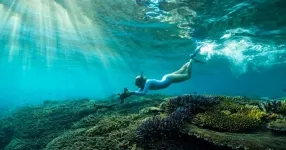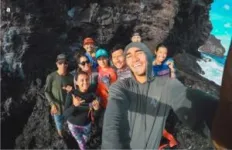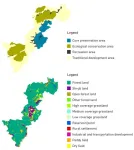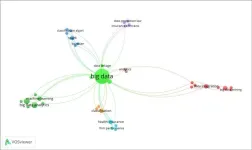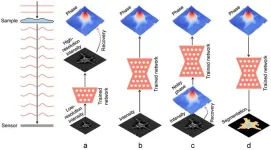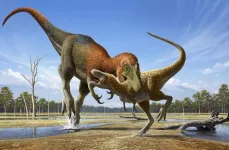(Press-News.org) In Hawaiʻi and across much of Oceania, Pacific Islanders celebrate the connections between their islands and the ocean that surrounds them. “As descendants of the ocean, the dearth of Native Hawaiians and Pacific Islanders (NHPI) in ocean science seems inconsonant,” writes a team of authors that includes University of Hawai‘i (UH) at Mānoa faculty, students, and alumni in an article in a special issue of the journal Oceanography, “Building Diversity, Equity, and Inclusion in the Ocean Sciences. The authors ask, “Where are all our island people in the ocean sciences?”
“To understand the root causes of this disparity and potential solutions, UH faculty, staff and students approached this problem through the lens of voyagers, examining the past course of history of the peoples of the Pacific and attempts to make headwinds in programs focused on increasing participation in ocean sciences,” said co-author Rosie Alegado, associate professor in the UH Mānoa School of Ocean and Earth Science and Technology (SOEST).
The article highlights programs in SOEST that are aimed at reducing barriers for Native Hawaiians in the geosciences—including summer bridge programs, internships, and other professional development programs. And, in better defining the persistent, systemic, and collective barriers that NHPI face within the western society and the academy, the authors identify gaps that conventional professional development programs aimed at minoritized groups in the geosciences have been unsuccessful in filling.
“One of the biggest gaps that we found related to Native Hawaiian-serving programs within the ocean sciences is that while many may be culturally based, few are Native Hawaiian led,” said lead author Haunani Kane, SOEST assistant professor. “Native Hawaiians are often overlooked in the development and leadership of Native Hawaiian and Pacific Islander-serving programs. Programs led by Native Hawaiian scientists and community members ensure that they are culturally centered safe spaces for students to collectively grow their identities as both Native Hawaiians and scientists.”
Importantly, the authors shared lessons learned from building two waʻa (canoes)–programs specifically designed to carry students forward toward futures that center oceanic ways of knowing.
SOEST Maile Mentoring Bridge
The SOEST Maile Mentoring Bridge program (Maile) was founded in 2013 with the goal of attracting and retaining more NHPIs into geoscience degree programs and careers. The foundation of Maile was to build and foster robust partnerships with neighboring community colleges within the UH system. Maile mentees are carefully paired with experienced mentors—SOEST graduate students, postdocs, or recent graduates.
“Looking back on the last 10 years of my life, the Maile Mentoring program has made such a huge impact,” said Diamond Tachera, study co-author and alumni and co-director of Maile. “As an undergraduate student, it was so important for me to see people, especially wāhine (women), who looked like me working and thriving in their scientific fields. Being part of the Maile ʻohana as a graduate student mentor also helped me to build confidence in myself as I continued to struggle to find my place and identity in academia. I will be forever grateful for the support and aloha that comes with being part of the Maile ʻohana.”
“I believe the Maile Mentoring program has been successful because it places an emphasis on meeting the needs of the whole student, not just their research endeavors,” said Alegado. “In focusing on creating a nurturing environment in SOEST, we place a stronger emphasis on retention of students, not just recruitment, which increases completion and graduation rates for NHPI.”
The MEGA Lab
To overcome traditional barriers related to retention of NHPIs in the ocean sciences, the multiscale environmental graphical analysis (MEGA) Lab, a predominantly Native Hawaiian-led lab and nonprofit physically located in Hilo, Hawai‘i, developed a research program that prioritizes inclusive research experiences. Foundational to their success has been incorporating community members and cultural values into research projects, and creating global partnerships that value Native Hawaiian research.
As a way to creatively explore what Native science and kuleana (responsibility) could look like if research and cultural priorities were equally weighted in all aspects of the research design, the MEGA Lab assembled a Native Hawaiian research team to embark on a 15-day voyage to Papahānaumokuākea Marine National Monument.
“That trip inspired me to re-imagine what research looks like when it's grounded in our ʻōiwi perspectives and how I can contribute to create more room for that to happen,” said Kainalu Steward, graduate student in the SOEST Department of Earth Sciences. “That experience helped me find kuleana in this collective work at the monument and reinforced my interest in pursuing higher education.”
Looking to the horizon
“Moving forward, we believe that in order to make progress in the representation, retainment, and success of Native Hawaiians and Pacific islanders in STEM, we must first address the historical and ongoing traumas of Native Hawaiians and Pacific Islanders through active engagement in reclamation of cultural identities and knowledge,” said Kane. “We also believe student success requires building community support systems both within and beyond UH where students can safely explore their whole identity as Indigenous scientists.”
The MEGA Lab founders are also calling for a culture change in academia and their “experiment to disrupt the hierarchical and stereotypical structures that exist in science and act as barriers to inclusion,” as they write in a second article in the special issue of Oceanography, provides a template. “Our goal was to create an interdisciplinary and inter-institutional lab that promotes an inclusive, equitable, and uplifting team environment where everyone can thrive in a fun and productive workspace.”
“All of the work we do to support Native Hawaiians, women, and other underrepresented groups (the fish) can only have limited success given our current toxic workplace culture (the fishbowl),” said Barbara Bruno, faculty specialist at SOEST and co-author of the first article. “The fishbowl —not the fish— needs to change.”
“Academia can often be reluctant to change, which is unfortunate as much of the workplace culture can serve as barriers to inclusion in STEM,” said John Burns, lead author of the second article and associate professor at UH Hilo. “We must embrace open-mindedness and be ready to transform the very culture of science in order to enhance diversity. Diverse perspectives and ideas not only foster a healthy work environment but can also serve as our most powerful asset, fueling the drive for new discoveries.”
END
Re-calibrating the sail plan for Native Hawaiians, Pacific Islanders in ocean sciences
2024-01-03
ELSE PRESS RELEASES FROM THIS DATE:
Monetized evaluation of landscape resources of national parks based on the willingness to pay of multiple interest groups
2024-01-03
In China, national parks represent the country’s most unique natural landscapes. Scientific evaluation of landscape resources is significant for preserving the authenticity and integrity of national parks. Taking Qianjiangyuan National Park System Pilot Zone as an example, this research investigated the willingness of internal group (residents and administrative staff) and external group (tourists) to pay for a hypothetical market project based on the pilot zone via Contingent Valuation Method to acquire the monetized value of landscape resources in the national park, and applied Logistic Regression to analyze the influencing factors. The results show ...
How big data transforms the insurance sector
2024-01-03
In 2022, the insurance industry made a whopping USD 6 trillion globally—more than the entire economy of big countries like Japan and Germany. A new study, published in The Journal of Finance and Data Science, looked at how technology, especially big data, is shaking things up in insurance. Big data means using a lot of information to make better decisions.
The study found that by using big data, insurance companies can understand risks better, offer fair prices and keep customers happier.
“What's surprising is how fast insurance companies are jumping on the big data bandwagon,” says first ...
Deep learning for phase recovery
2024-01-03
Light, as an electromagnetic field, has two essential components: amplitude and phase. However, optical detectors, usually relying on photon-to-electron conversion (such as charge-coupled device sensors and the human eye), cannot capture the phase of the light field because of their limited sampling frequency. Fortunately, as the light field propagates, the phase delay also causes changes in the amplitude distribution; therefore, we can record the amplitude of the propagated light field and then calculate the corresponding phase, called phase recovery. Some common phase ...
Chicken whisperers: humans crack the clucking code
2024-01-03
A University of Queensland-led study has found humans can tell if chickens are excited or displeased, just by the sound of their clucks.
Professor Joerg Henning from UQ’s School of Veterinary Science said researchers investigated whether humans could correctly identify the context of calls or clucking sounds made by domestic chickens, the most commonly farmed species in the world.
“In this study, we used recordings of chickens vocalising in all different scenarios from a previous experiment,” ...
Newly discovered genetic mutation protects against Parkinson’s disease and offers hope for new therapies
2024-01-03
A previously unidentified genetic mutation in a small protein provides significant protection against Parkinson’s disease and offers a new direction for exploring potential treatments, according to a new USC Leonard Davis School of Gerontology study.
The variant, located in a mitochondrial microprotein dubbed SHLP2, was found to be highly protective against Parkinson’s disease; individuals with this mutation are half as likely to develop the disease as those who do not carry it. The variant form of the protein is relatively rare and is found primarily in people of European descent.
The findings appear on January 3, 2024, in the journal Molecular Psychiatry.
First ...
First dive survey of Lake Tahoe’s lakebed finds high amounts of plastic and other litter
2024-01-03
Plastic litter is a growing problem around the world, and new research shows that the bottom of Lake Tahoe is no exception. In one of the first studies to utilize scuba divers to collect litter from a lakebed, 673 plastic items were counted from just a small fraction of the lake.
In the study, published in the November issue of the journal Applied Spectroscopy, researchers from DRI and the UC Davis Tahoe Environmental Research Center teamed up with the nonprofit Clean Up the Lake to take a close look at the litter. First, ...
Study on extremely preterm infants provides important healthcare knowledge
2024-01-03
Infants born extremely prematurely need to get enrichment as an addition to breast milk. But does it make any difference whether the enrichment is made from breast milk or cow’s milk when it comes to the risk of severe complications in children? This has been investigated by a large clinical study led from Linköping, Sweden.
Infants born extremely prematurely, between weeks 22 and 27 of pregnancy, are among the most vulnerable patients in healthcare. The risk of serious complications is very high. Almost one in four extremely premature babies die before the age of one.
There is strong research support for giving breast ...
New research shows “Juvenile T. rex” fossils are a distinct species of small tyrannosaur
2024-01-03
A new analysis of fossils believed to be juveniles of T. rex now shows they were adults of a small tyrannosaur, with narrower jaws, longer legs, and bigger arms than T. rex. The species, Nanotyrannus lancensis, was first named decades ago but later reinterpreted as a young T. rex.
The first skull of Nanotyrannus was found in Montana in 1942, but for decades, paleontologists have gone back and forth on whether it was a separate species, or simply a juvenile of the much larger T. rex.
Dr Nick Longrich, from the Milner Centre for Evolution at the University ...
Using electricity, scientists find promising new method of boosting chemical reactions
2024-01-02
As the world moves away from gas towards electricity as a greener power source, the to-do list goes beyond cars. The vast global manufacturing network that makes everything from our batteries to our fertilizers needs to flip the switch, too.
A study from UChicago chemists found a way to use electricity to boost a type of chemical reaction often used in synthesizing new candidates for pharmaceutical drugs.
Published Jan. 2 in Nature Catalysis, the research is an advance in the field of electrochemistry and shows a path forward to designing ...
Combine mindfulness with exercise for mental health boost in 2024 – study
2024-01-02
For people looking to start 2024 with a new routine to feel fitter and happier, a new study from the University of Bath suggests that combining mindfulness with exercise could be your key to success.
A study, published in the academic journal Mental Health and Physical Activity, suggests that life changes which combine both physical activity and mindfulness are most effective at lifting mood and improving health and wellbeing.
Both physical activity and mindfulness practice have well established psychological benefits. However, ...
